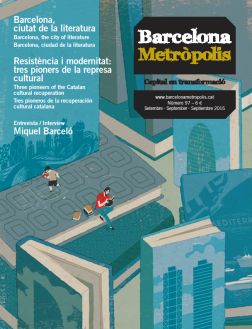Barcelona is the setting and the protagonist of a host of literary works, so much so that imaginary worlds come alive when a reader walks through its streets for the first time, or when a local returns to a place after having read a novel that is set there.

Foto: Albert Armengol
Café Moka on La Rambla, seen from the Acadèmia de Ciències, above Poliorama theatre. In his Homage to Catalonia, George Orwell narrates how he was holed up on the roof of the building with other POUM militiamen during the May Days of 1937 in order to defend the party headquarters, which were next to the cafe and which had been occupied by government Assault Guards.
Reading a city means taking a journey to discover its urban essence. When we read, we hope to satisfy our curiosity and close the book with a feeling that we have come to know, to a certain extent, the lives of those who populate the city. Walking and reading seem to me to be the two most perfect ways of getting to know a city. I think that walking has a very intense evocative power, and in fact, the combination of movement and presence (embodied in the flâneur and the voyeur) means that many writers search for inspiration in this oh-so-everyday activity. When we want to immerse ourselves in a far-flung city, literature helps to transport us to streets which we have to imagine, filling our imagination with characters invented by the writer. In this way, the city we read about becomes home to a subjective imaginary that is perfectly transmissible and legitimate.
But when the city is our own, literature colours our perception like a veil woven by the writer, adding to our previous perception of the place. Barcelona is the setting and protagonist of a whole host of literary works, so much so that imaginary worlds come alive when a reader walks through its streets for the first time, or when a local returns to a place after having read a novel that is set there. To give just a few examples, the Gràcia of Rodoreda takes us back to an era of rooftops and post-war years, Orwell’s Rambla is besieged by the ghosts of militiamen and women, we try to guess Carvalho’s favourite table at Casa Leopoldo, and if we visit the Quatre Gats, we would never be able to complete the list of characters and writers who have passed through its doors.
Despite this rich heritage, for some reason we are less aware of Barcelona’s literary character than when we visit Paris or London, or certain UNESCO Cities of Literature such as Dublin, Edinburgh, Krakow and Prague. What is the secret behind these cities being read more? Could literature have a stronger presence there? One reason might be the international profile of their literature, but in many cases there has also been a drive to make this heritage visible in public spaces, doting the city with a literary air. In these cities, there is no lack of plaques, statues, street names, literary tours and activities that highlight the characters and writers who brought soul to the place. Shakespeare’s Globe, the Café Les Deux Magots and the statues of Joyce and Pessoa are hallowed places of pilgrimage for readers and the pride of local residents. Edinburgh is creating a literary district around the Royal Mile, and Krakow has developed a diverse programme of literature in public spaces with poems projected onto façades, including the poem Barcelona, a composition in homage to the bohemian city’s homonymous bar.
The presence of literature in public spaces has three main missions: to disseminate literary heritage, to promote awareness of this heritage, and to build up an identity thanks to the combination of the first two factors. If I know the inspiring essence of my city and share it, my bonds to the city are strengthened and I will very probably feel myself to be an ambassador of a city that has much to offer in terms of culture. At the same time, the preservation of these literary spaces will serve as a source of inspiration for new generations curious to feel, both mentally and physically, the influence of established writers.
Barcelona has a diverse heritage, but while we decide which is the “great novel of Barcelona”, we can concentrate on its unwavering ability to charm, to feed our imagination through the diversity of its streets and the vision of its literary works. We have the opportunity to continue working to raise the profile of our writers, through the same methods we have always used, of course, but perhaps with greater momentum. The streets are already brimming with literature, we just have to help passers-by discern it




Pingback: Barcelona, ciutat literària | Núvol